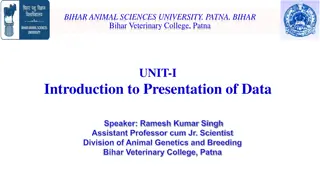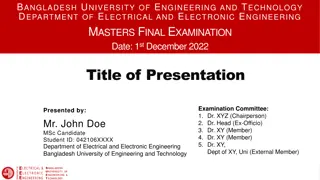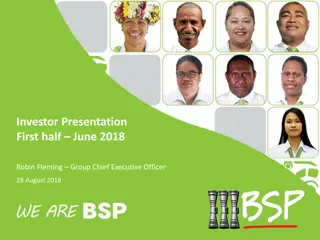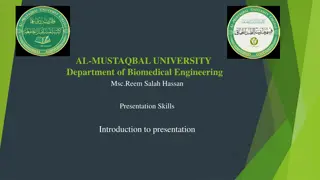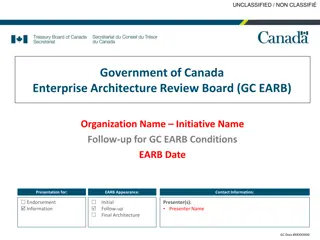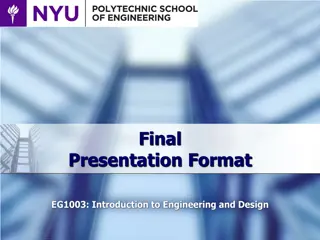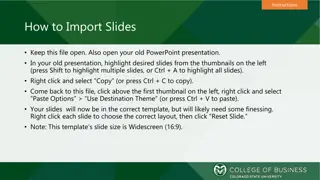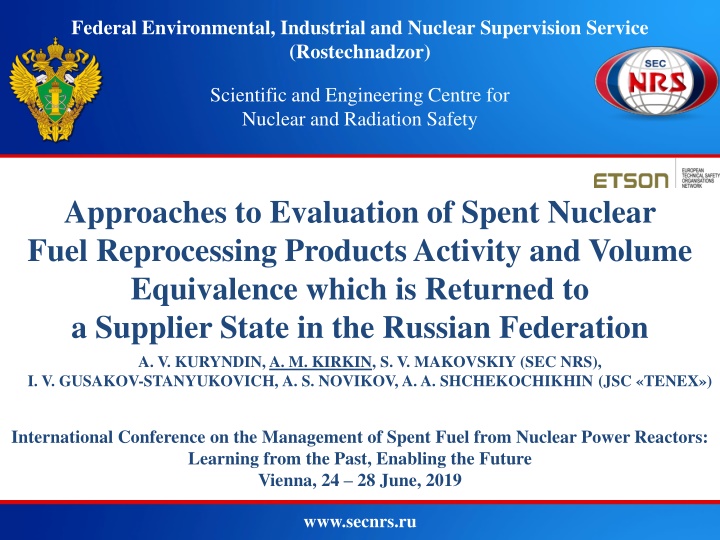
Review of Return Process for Spent Nuclear Fuel Reprocessing Products
Discover the process of evaluating and returning spent nuclear fuel reprocessing products to supplier states in the Russian Federation. Learn about handling radioactive materials, legal regulations, and international cooperation in managing nuclear fuel. Explore the complexities of determining activity equivalence and the procedures involved in returning reprocessing products according to regulatory guidelines.
Download Presentation

Please find below an Image/Link to download the presentation.
The content on the website is provided AS IS for your information and personal use only. It may not be sold, licensed, or shared on other websites without obtaining consent from the author. If you encounter any issues during the download, it is possible that the publisher has removed the file from their server.
You are allowed to download the files provided on this website for personal or commercial use, subject to the condition that they are used lawfully. All files are the property of their respective owners.
The content on the website is provided AS IS for your information and personal use only. It may not be sold, licensed, or shared on other websites without obtaining consent from the author.
E N D
Presentation Transcript
Federal Environmental, Industrial and Nuclear Supervision Service (Rostechnadzor) Scientific and Engineering Centre for Nuclear and Radiation Safety Approaches to Evaluation of Spent Nuclear Fuel Reprocessing Products Activity and Volume Equivalence which is Returned to a Supplier State in the Russian Federation A. V. KURYNDIN, A. M. KIRKIN, S. V. MAKOVSKIY (SEC NRS), I. V. GUSAKOV-STANYUKOVICH, A. S. NOVIKOV, A. A. SHCHEKOCHIKHIN (JSC TENEX ) International Conference on the Management of Spent Fuel from Nuclear Power Reactors: Learning from the Past, Enabling the Future Vienna, 24 28 June, 2019 www.secnrs.ru
States where Russian Power Units are Constructed ore Operated The Russian Federation is a world leader in construction of power units abroad Currently more than 30 power units with VVER-type reactors are being constructed in the world During operation of foreign power units Russian specialists provide technical and scientific cooperation www.secnrs.ru 2
Handling with SNF of Power Units Located Outside the Russian Federation Fresh nuclear fuel Foreign NPP Russian Federation SNF Nuclear fuel for power units of foreign NPPs is supplied by the Russian Federation Spent nuclear fuel (SNF) after several years of preliminary storage on NPP is sent to the Russian Federation for its technological storage and reprocessing www.secnrs.ru 3
Return of SNF Reprocessing Products SNF = U + Pu + . . (Np, Am, Cm, etc.) + FP (137Cs, 90Sr, 144Ce , etc.) Spent nuclear fuel is characterized by high level of radioactivity and in order to sustain radioecological balance the activity equivalent of foreign SNF shall be returned to its supplier Due to complexity of SNF composition evaluation of activity equivalent is a complicated process www.secnrs.ru 4
Legal and Regulatory Basis for Return of SNF Reprocessing Products No 170-FZ On the Use of Nuclear Energy Decree of the Government of the Russian Federation of 11.07.2003 No. 418 Methods for determination of the activity equivalent (unique in every case) Safety guide RB-092-13 Federal laws Acting regulatory documents establish that activity equivalent of SNF imported to the Russian Federation shall be returned in a form of reprocessing products No 7-FZ On environmental protection Current practice implies the return of activity equivalent in the form of solidified high-level radioactive recommendations of RB-092-13 waste in accordance with www.secnrs.ru 5
Methodology of Evaluation of Activity Equivalence of SNF and Reprocessing Products in a Form of High-Level Waste (1/3) A criteria of dose equivalents (Sv) of SNF and reprocessing products (HLW) equality at the time of return is used = HLW SNF ( ) ( ) E t E t return return Dose equivalent is determined as a sum of dose equivalents of all radionuclides in SNF/HLW = + + SNF FP actinides AP ( ) ( ) ( ) ( ) E t E t E t E t k = i = HLW HLW i E ( ) ( ) E t t 1 The dose equivalents of nuclear materials in SNF are not taken into account in the calculations www.secnrs.ru 6
Methodology of Evaluation of Activity Equivalence of SNF and Reprocessing Products in a Form of High-Level Waste (2/3) The dose equivalent of a single radionuclide is determined by dose coefficient and activity A t E ) ( = i i i ( ) t K Dose coefficients are established in Radiation Safety Standard (NRB-99/2009) (harmonized with ICRP publications) 8.00E-08 Dose coefficient, Sv/Bk 7.00E-08 NRB-99/2009 6.00E-08 5.00E-08 4.00E-08 3.00E-08 Some examples of dose equivalents 2.00E-08 1.00E-08 0.00E+00 Cs-137 Sr-90 Ru-106 Cm-242 www.secnrs.ru 7
Methodology of Evaluation of Activity Equivalence of SNF and Reprocessing Products in a Form of High-Level Waste (3/3) Activity SNF import Return of the activity equivalent of reprocessing products SNF technological storage and reprocessing in Russia Storage in cooling pool 0 10 20 30 40 50 60 Periods after the reactor core discharge, years Approximate time scale of SNF handling www.secnrs.ru 8
Approaches to Return of SNF Reprocessing Products (1/4) Current approach return to a supplier state of SNF dose equivalent in a form of HLW which are is vitrified in aluminophosphate matrix and contain full specter of radionuclides Perspective approaches 1 2 return to a supplier state of SNF dose equivalent in a form of HLW which are is vitrified in borosilicate matrix and contain only isotopes Cs+Sr and they decay products taking into account nuclear materials in SNF and return of dose equivalent in a form of fresh MOX or REMIX fuel and HLW with full specter of radionuclides 3 (combined approach) return to a supplier state of SNF dose equivalent in a form of MOX or REMIS fuel and HLW, containing only Cs+Sr fraction www.secnrs.ru 9
Approaches to Return of SNF Reprocessing Products (2/4) Approach No 1 (Return of fractionated HLW) SNF HLW ( s+Sr) Advantages Possible reduction of HLW volume (due to concentration of more activity in HLW) No necessity to construct repositories for final disposal of HLW in deep geological formations Disadvantages Fractionation technology is now under development www.secnrs.ru 10
Approaches to Return of SNF Reprocessing Products (3/4) Approach No 2 (return of fuel with regenerated nuclear materials) SNF HLW + fuel (MOX, REMIX) Advantages Reduction of HLW volume due to use of regenerated materials in fuel cycle Economy due to reduction of natural uranium consumption Disadvantages Need of additional justification of possibility of regenerated fuel loading in a core www.secnrs.ru 11
Approaches to Return of SNF Reprocessing Products (4/4) Approach No 3 (combined) SNF Advantages Large reduction of HLW volume (up to full compensation by fuel) Economy due to reduction of natural uranium consumption No necessity to construct repositories for final disposal of HLW in deep geological formations Disadvantages Analogical to disadvantages of approaches No 1 and 2 HLW (Cs+Sr) + fuel (MOX, REMIX) www.secnrs.ru 12
Preliminary Analysis of HLW Mass which shall be Returned in Different Scenarios 2500 Mass of HLW/SFA, kg Not fractionated 2000 - 15 % 1500 Cs+Sr only 1000 - 70 % - 75 % 500 - 90 % - 96 % 0 HLW only HLW + REMIX HLW + MOX Quantity of returned HLW significantly decreases if regenerated nuclear materials are involved and HLW is fractionated Assumptions Reactor type VVER-1200 Initial enrichment of SNF 4,95 % of 235U Burnup 60 GWt day/HMt Time of storage in pool on NPP 10 years Return of reprocessing products is implemented after 20 years after discharge www.secnrs.ru 13
Conclusion Current Russian approach to return of SNF reprocessing products is approved by previous experience and implemented in methods of HLW return which are produced during reprocessing of VVER-type reactors and research reactors fuel Current approach can be additionally improved through the involvement of the regenerated nuclear materials and fractionation of HLW Volume of radioactive waste to be returned to the Supplier s state significantly reduces (up to 96 %) in case of the return of the SNF activity equivalent in the form of fresh uranium-plutonium fuel (REMIX or MOX fuel) and HLW in borosilicate matrix, which contain only isotopes of Cs and Sr The presented approaches could be used for development of new methodology of return of reprocessing products for SNF of foreign Russian-developed power units, which will be possible competitive advantage of Russian technologies on market www.secnrs.ru 14
Federal Environmental, Industrial and Nuclear Supervision Service Scientific and Engineering Centre for Nuclear and Radiation Safety Thank you for attention! www.secnrs.ru




